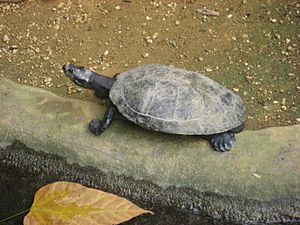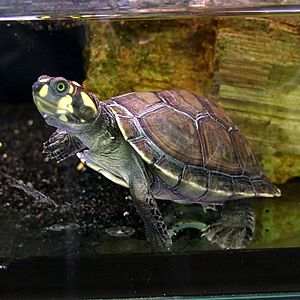Yellow-spotted river turtle facts for kids
Quick facts for kids Yellow-spotted Amazon river turtle |
|
|---|---|
 |
|
| Adult at Krefeld Zoo | |
| Conservation status | |
| Scientific classification | |
| Genus: |
Podocnemis
|
| Species: |
unifilis
|
| Synonyms | |
|
|
The yellow-spotted Amazon river turtle (Podocnemis unifilis) is one of the largest South American river turtles. It is also known as the yellow-headed sideneck turtle or yellow-spotted river turtle. In some places, people call it the taricaya.
This turtle can grow up to 45 cm long. It can also weigh as much as 8 kg. You can recognize this turtle by its black or brown oval top shell, which is called a carapace. It has small bumps on its shell. The yellow spots on the side of its head give this turtle its common name. These spots are brightest when the turtles are young. They tend to fade as the turtles get older. Female turtles can grow to be twice the size of males.
Contents
What is a Side-necked Turtle?
The yellow-spotted Amazon river turtle is a type of side-necked turtle. This means it does not pull its head straight back into its shell. Instead, it bends its neck sideways. This lets it tuck its head safely under the edge of its shell. Side-necked turtles belong to a group called Pleurodira.
Where Do They Live?
These turtles are native to South America. They live in the Amazon and Orinoco river systems. They are also found in rivers in the Guianas. They prefer calm waters like tributaries and large lakes. During flood season, they might swim into flooded forests or lakes on floodplains.
What Do They Eat?
Yellow-spotted Amazon river turtles eat many different things. Their diet includes fruits, seeds, and various aquatic plants. They also eat fish and small invertebrates. Young turtles eat plant matter, grasses, fruits, leaves, and even dead animals. They also eat mollusks.
Reproduction and Life Cycle
Female turtles lay two groups of eggs each year. Each group can have between four and 35 eggs. They build their nests in sandy areas along river banks. The eggs will hatch about 66 to 159 days after they are laid.
The turtles lay their eggs at the driest time of the year. This helps make sure the nests are not washed away by floods during the rainy season. The temperature of the nest affects if the baby turtles will be male or female. Eggs kept below 32 degrees Celsius will hatch as males. Eggs kept above 32 degrees Celsius will hatch as females.
A few days after hatching, the young turtles start to find food on their own.
Conservation and Threats
In the 1960s, many yellow-spotted Amazon river turtles were part of the pet trade in America. Today, bringing these turtles into the United States is strictly controlled by law. However, there are groups of these turtles living in zoos and with private collectors in the U.S. Some of these turtles have lived for more than 30 years in captivity.
These turtles face dangers from many animals. Humans sometimes hunt them. Birds, snakes, large fish, frogs, and other mammals also prey on them.
See also
 In Spanish: Terecay o taricaya para niños
In Spanish: Terecay o taricaya para niños



